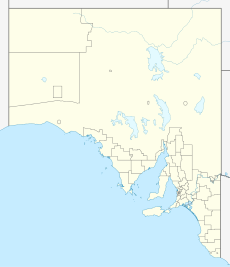Dukes Highway
|
Dukes Highway South Australia |
|
|---|---|
| Coordinates |
|
| Type | Highway |
| Length | 190 km (118 mi) |
| Route number(s) |
|
| Former route number |
|
| West end |
|
|
|
| East end |
|
| Major settlements | Coonalpyn, Keith, Bordertown |
|
Highways in Australia National Highway • Freeways in Australia Highways in South Australia |
|
The Dukes Highway is a 189 kilometre highway corridor in South Australia which is part of the link between the Australian cities of Adelaide and Melbourne. It is part of the National Highway system spanning Australia, and is signed as National Highway A8.
The Dukes Highway starts in Tailem Bend on the Princes Highway and extends southeast to the state border near Bordertown, South Australia. The highway continues in Victoria as the Western Highway, with the same route signage (National A8). The length of the highway in South Australia is around 191 km, joining onto the Western Highway in Victoria which is 443 km. It is a single carriageway of one lane each way, plus a total of 36 overtaking lanes. Approximately 90 kilometres (56 mi) has "wide centre lines" providing a 1.2 metres (3 ft 11 in) boundary between traffic travelling in opposite directions.
Generally, the quality of the Dukes Highway is of a high standard, with the entire road having wide lane widths and sealed shoulders with at least five (and usually six) metres clear beyond the edge line. The final 17 km of the highway after Bordertown, was originally built on unstable ground but was re-constructed in 2005. There are a total of 16 rest areas or parking bays along the Dukes Highway, at approximately 15km intervals. Each one provides sealed parking space for at least four B-double trucks, with bins, tables, shelter and lighting.
The Dukes Highway runs through the northern part of the Limestone Coast region of South Australia. The route and many of the settlements (including Bordertown) were established in the 1850s to supply water to horses for the gold escorts from the Victorian goldfields to Adelaide.
Gold was taken to Adelaide rather than the closer Melbourne because a higher price was offered there. The higher price was offered to stop the South Australian economy from collapsing as all the labourers were heading to the Victorian Goldfields. The 'Bullion Act' was passed and an Assay office was established in Adelaide for the assaying and stamping of gold in 1852. It is claimed that this saved South Australia from bankruptcy.
...
Wikipedia

